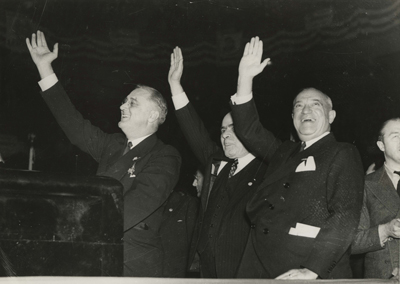Wagner Act Turns 77
When FDR signed the National Labor Relations Act (Wagner Act) into law on July 5, 1935, he declared:
“A better relationship between labor and management is the high purpose of this Act. By assuring the employees the right of collective bargaining it fosters the development of the employment contract on a sound and equitable basis. By providing an orderly procedure for determining who is entitled to represent the employees, it aims to remove one of the chief causes of wasteful economic strife. By preventing practices which tend to destroy the independence of labor, it seeks, for every worker within its scope, that freedom of choice and action which is justly his.”
Because of the Wagner Act, union membership increased dramatically throughout the 1930s, and by 1940 there were nearly 9 million union members in the United States. The system of orderly industrial relations that the Wagner Act helped to create led to an era of unprecedented productivity, improved working conditions, and increased wages and benefits.
Today, the Wagner Act stands as a testament to the reform efforts of the New Deal and to the tenacity of Senator Robert Wagner in guiding the bill through Congress so that it could be signed into law by President Roosevelt.

For more on this topic, see the web article, FDR and the Wagner Act: “A Better Relationship Between Management and Labor.

Before becoming President of the United States, Franklin Delano Roosevelt was elected Governor of New York State in 1928. In October of 1929, the stock market crashed and the Great Depression began. The suffering of the people of New York and all across America was terrible. Many Americans were jobless, homeless, and deprived of their savings when banks began closing all across America.
FDR quickly established a reputation as a progressive governor who used the power of government to alleviate the suffering and make lives better. He supported aid to the farmer and was a strong supporter of labor laws to protect workers. With the onset of the Depression, Roosevelt developed a strong reputation for supporting active government intervention to help the unemployed. He established the temporary Emergency Relief Administration to help the homeless and unemployed. Roosevelt picked Harry Hopkins to lead the agency, and it became a prototype to the program Roosevelt was to unveil in the New Deal. Roosevelt developed a national reputation as an activist Governor, who took charge and made things happen.
As Governor of New York, FDR took several steps on the road to unemployment insurance. At a national Governors’ Conference in Salt Lake City at the end of June1930, he publicly came out in support of unemployment insurance as an inevitable form of social provision. While this idea was being fairly widely discussed in academic circles, Roosevelt’s embrace of the principle of unemployment insurance was one of the earliest by a political figure of national prominence. Roosevelt’s speech was the headline event of the Conference in many papers around the country. In January 1931, Roosevelt invited the governors of six other industrial states to join with New York for a conference on how they might better coordinate their responses to the crisis of unemployment. It was an attempt by Roosevelt to follow through, on a regional level, with his bold call for unemployment insurance issued at the Salt Lake conference.
FDR was, throughout his political life, on the side of ordinary Americans and tried many different policies to help those who needed a helping hand.